
BOULANGERITE
Specimen bul-7
$ 26.00
Dims: 1.2 x 1.0 x 0.6" (3.0 x 2.5 x 1.5 cm)
Wt: 22.3 g w/ specimen box
Mazapil, Zacatecas, Mexico
A layer of matted, interwoven Boulangerite crystals coats part of the pyrite base of this small thumbnail specimen. These needles do not exceed 0.5" (1.3 cm) in length or 1 mm in diameter. They appear to be in good condition, though that is not easy to determine. Quality of form is also difficult to judge without powerful magnification, but they appear to have reasonably good monoclinic form. All have a moderately dark gray color and a rather dull metallic luster, and are, of course, opaque. The pyrite base is made up of many partly intergrown crystals that are in resnoably good condition. Their cubic form is good, but several of the smaller crystals are intensely warped, as they are long and prismatic, with a diamond-shaped cross-section. I wonder if they are even pyrites! The specimen is affixed inside a plastic specimen box with hot glue.
 Amethyst Galleries' Mineral Gallery MINERALS |
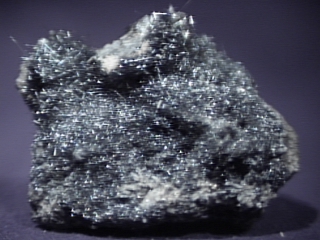
BOULANGERITE specimen bul-1
$ 40.00
$ 40.00
Dims: 2.9" x 2.1" x 1.5"(7.4 x 5.3 x 3.8 cm)
Wt: 6.27 oz.177.8 g)
Noche Buena, Durango, Mexico
This specimen contains hundreds of fibrous, needle-like Boulangerite crystals on a matrix of sphalerite and calcite. The Boulangerites reach a maximum length of about 0.5"(1.3 cm) and are thinner than human hairs. They have a gray color and metallic luster, and are congregated into a dense matting that covers at least 30% of the host rock's surface area. Given the crystals' occurrence as superfine needles, this specimen should be handled as little as possible and with great care, as many of the needles are loose and will easily come off onto one's hands and clothes, and whatever else may be underneath it. The calcites in the host rock are small and mostly broken, but a few thin dogtooth crystals are intact. There is a lot of sphalerite, though, and it occurs in large, well-formed prismatic crystals with a deep brown color and subadamantine luster. I really like these thin needles- there aren't many metallic minerals that occur in such a form for this price.

bul-1 ($ 40.00)
Noche Buena, Durango, Mexico
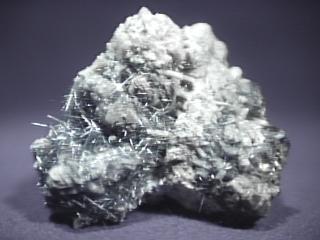
BOULANGERITE specimen bul-2
$ 30.00
$ 30.00
Dims: 2.9" x 2.1" x 1.5"(7.4 x 5.3 x 3.8 cm)
Wt: 6.27 oz.177.8 g)
Noche Buena Mine, Durango, Mexico
This specimen contains far too many Boulangerite crystals for me to effectively count. There must be at least 100, and probably many more. The largest of these fibrous needles extends about 0.5"(1.3 cm), and all are extremely thin, even more so than human hair. The crystals have a gray color and a metallic luster, and rest on a matrix that is made up of a variety of minerals, including quartz, pyrite, and sphalerite. Though these minerals show some definite crystal form, none occur as complete crystals. As the Boulangerite crystals are so thin, this piece should be handled with care, and one should wash his or her hands after handling it, as little needles often fall off onto hands, clothes, and anything that is under it.

bul-2 ($ 30.00)
Noche Buena Mine, Durango, Mexico
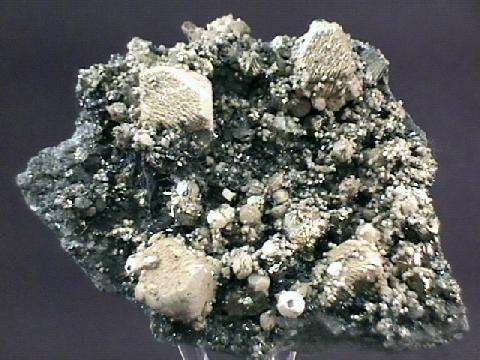
BOULANGERITE specimen bul-3
$ 130.00
$ 130.00
Dims: 3.3" x 3.0" x 1.2" (8.4 x 7.6 x 3.0 cm)
Wt: 7.25 oz. (205.7 g)
Hulcani Mine, Ancash, Peru
This hand specimen consists of scores of gray metallic Boulangerite needles resting among two other minerals on a gray quartzite slab. The Boulangerites achieve lengths of over 0.5" (1.3 cm), but are all at least as thin as human hair. Though a few of them are gathered in radiating sprays, most seem to be randomly arranged. They grow among scores of large, blocky siderite crystals that have a pale brown coloration and a pearly luster. These crystals range in size from a few millimeters to over 0.5" (1.3 cm) in each dimension and show excellent trigonal prismatic form that appears almost pseudo-octahedral in the largest crystals. They all are most definitely opaque. Also accompanying the Boulangerites are several pyrites or chalcopyrites, most of which seem to be either twinned or heavily intergrown. Their form appears to be either cubo-octahedral or a variation of the disphenoid, but it is very difficult to tell. There are several more of these pyrites on the other side of the quartzite host rock, along with a few more Boulangerite needles and what appear to be some tiny tennantites or tetrahedrites. Although this specimen's documentation says that the golden crystals are pyrites, their form and depth of color have more or less convinced me that they are chalcopyrites.
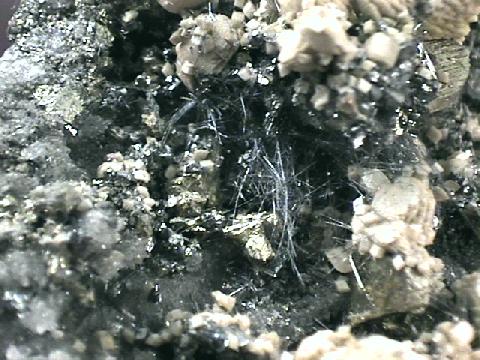

bul-3 ($130.00)
Hulcani Mine, Ancash, Peru
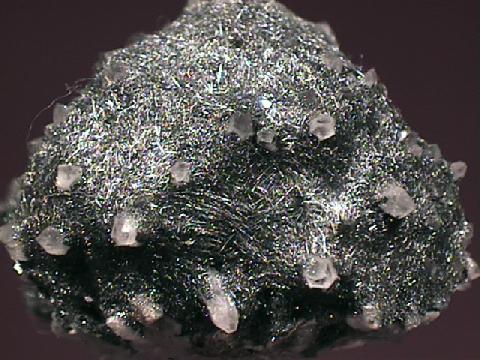
BOULANGERITE specimen bul-4
$ 32.00
$ 32.00
Dims: 1.1 x 1.0 x 1.0" (2.8 x 2.5 x 2.5 cm)
Wt: 19.7 g
Trepca, Yugoslavia
This interesting little thumbnail specimen appears to consist of a matted coating of extremely fine Boulangerite needles that have coated over a small quartz cluster. Among the dark gray needles there are at least 10 trigonal pyramidal terminations of hexagonal prismatic quartz crystals sticking out of the Boulangerite coating. The Boulangerite has all the hallmarks of its species, being superthin, somehwhat flexible crystals that have a moderately dull metalic luster. Accompanying these crystals are several cubic pyrites and one or two sphalerites, one of which appears to be twinned.


bul-4 ($ 32.00)
Trepca, Yugoslavia
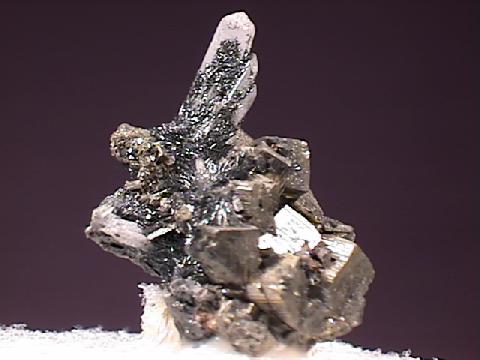
BOULANGERITE specimen bul-5
$ 32.00
$ 32.00
Dims: 1.0 x 0.7 x 0.7" (2.5 x 1.8 x 1.8 cm)
Wt: 15.7 g w/ specimen box
Mazapil, Zacatecas, Mexico
Though Boulangerite makes up only a small portion of the mass of this thumbnail specimen, it is still quite visible and easy to study. The Boulangerite rests in rather sheltered areas and so is in excellent condition, showing almost no damage. The largest of these needles does not exceed 0.1" (3 mm), and all are so thin that their form is impossible to study without high magnification. They have the standard moderately dark silver-gray coloration and metallic luster. They line a few depressions on their base, which is made up of a few hexagonal quartz prisms that are intergrown with a cluster of heavily intergrown pyrite cubes. The specimen is hot-glued into a plastic specimen box.

bul-5 ($ 32.00)
Mazapil, Zacatecas, Mexico
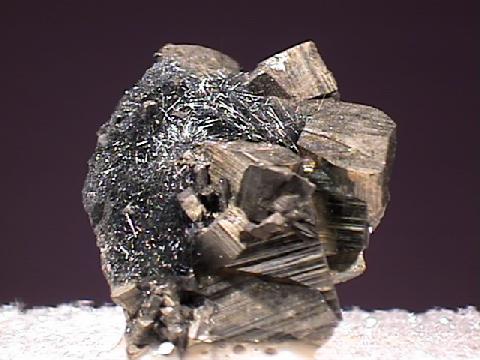
BOULANGERITE specimen bul-6
$ 26.00
$ 26.00
Dims: 1.0 x 0.7 x 0.4" (2.5 x 1.8 x 1.0 cm)
Wt: 17.1 g w/ specimen box
Mazapil, Zacatecas, Mexico
A bed of matted Boulangerite crystals rests on the crystalline pyrite base of this small thumbnail specimen. These needles do not exceed 0.4" (1.0 cm) and are in fair condition, as a considerable number of them appear to be crushed. Their monoclinic form is impossible to study without magnification. All have the standard moderately dark silver-gray coloration and metallic luster. The pyrite base is made up of several very warped, intergrown crystals, most of which are incomplete. The specimen is mounted in a plastic specimen box.

bul-6 ($ 26.00)
Mazapil, Zacatecas, Mexico

BOULANGERITE specimen bul-7
$ 26.00
$ 26.00
Dims: 1.2 x 1.0 x 0.6" (3.0 x 2.5 x 1.5 cm)
Wt: 22.3 g w/ specimen box
Mazapil, Zacatecas, Mexico
A layer of matted, interwoven Boulangerite crystals coats part of the pyrite base of this small thumbnail specimen. These needles do not exceed 0.5" (1.3 cm) in length or 1 mm in diameter. They appear to be in good condition, though that is not easy to determine. Quality of form is also difficult to judge without powerful magnification, but they appear to have reasonably good monoclinic form. All have a moderately dark gray color and a rather dull metallic luster, and are, of course, opaque. The pyrite base is made up of many partly intergrown crystals that are in resnoably good condition. Their cubic form is good, but several of the smaller crystals are intensely warped, as they are long and prismatic, with a diamond-shaped cross-section. I wonder if they are even pyrites! The specimen is affixed inside a plastic specimen box with hot glue.

bul-7 ($ 26.00)
Mazapil, Zacatecas, Mexico